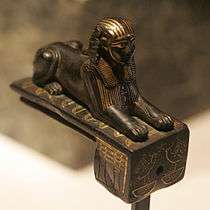Nine bows

The nine bows is a term used in Ancient Egypt to represent the traditional enemies of Egypt. The peoples covered by this term changed over time, as enemies changed, and there is no true list of the nine bows.[1] When illustrated the nine bows are usually shown as dressed differently from each other, as they each personify a specific enemy relevant to the time period.
Pharaoh Djoser
One of the oldest representations of the Nine bows is on the seated statue of Pharaoh Djoser–his feet rest upon part of the nine bows. The Rekhyt bird-(lapwing) is often associated in the iconography, with the phrase: "all the peoples give praise".
Tutankhamun's tomb
Pharaoh-King Tutankhamun has a famous representation of the Nine Bows, and the nine foreign enemies. The tomb was closed with a knotted rope, and the rope impressed with a clay seal. The seal contains an impression with Anubis, reclining as a jackal, at the top list of the Nine foreign rebels, in a long, vertical cartouche-image.
 The Keftiu-
The Keftiu-
(Caphtor)-K-f-t-U-foreign land determinative; (defeated peoples, Ramses II Temple at Abydos) Thutmose III sphinx statuette
Thutmose III sphinx statuette Nectanebo II statue pedestal.
Nectanebo II statue pedestal.
Ntr-Nfr-(Pharaoh-Wonderful), and "All the people make praise".
Notes and references
References
| Wikimedia Commons has media related to Nine bows (hieroglyphs). |
- ↑ Wilson, 2005, p.61
Bibliography
- Kevin A. Wilson (2005). The Campaign of Pharaoh Shoshenq I Into Palestine. Mohr Siebeck.